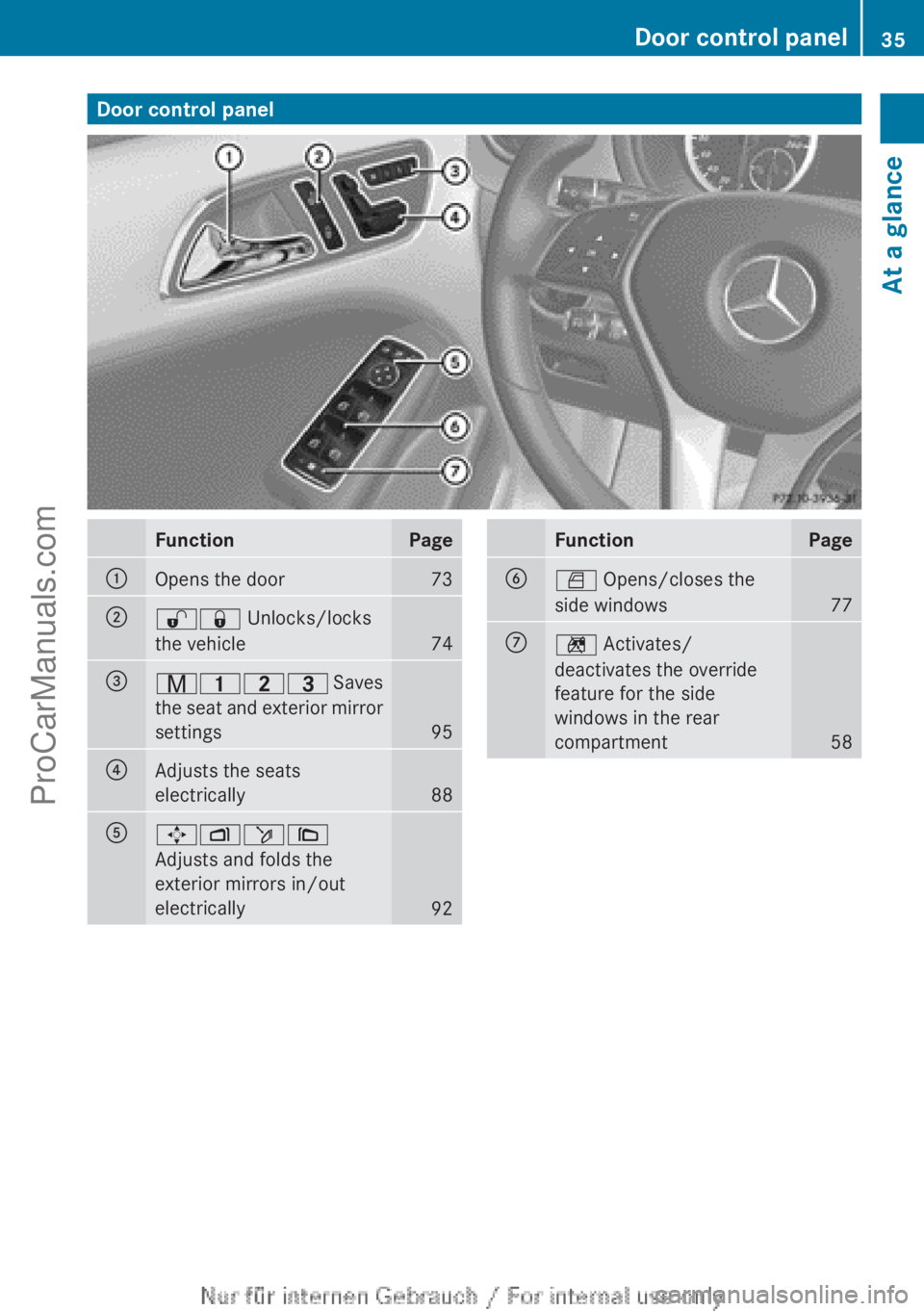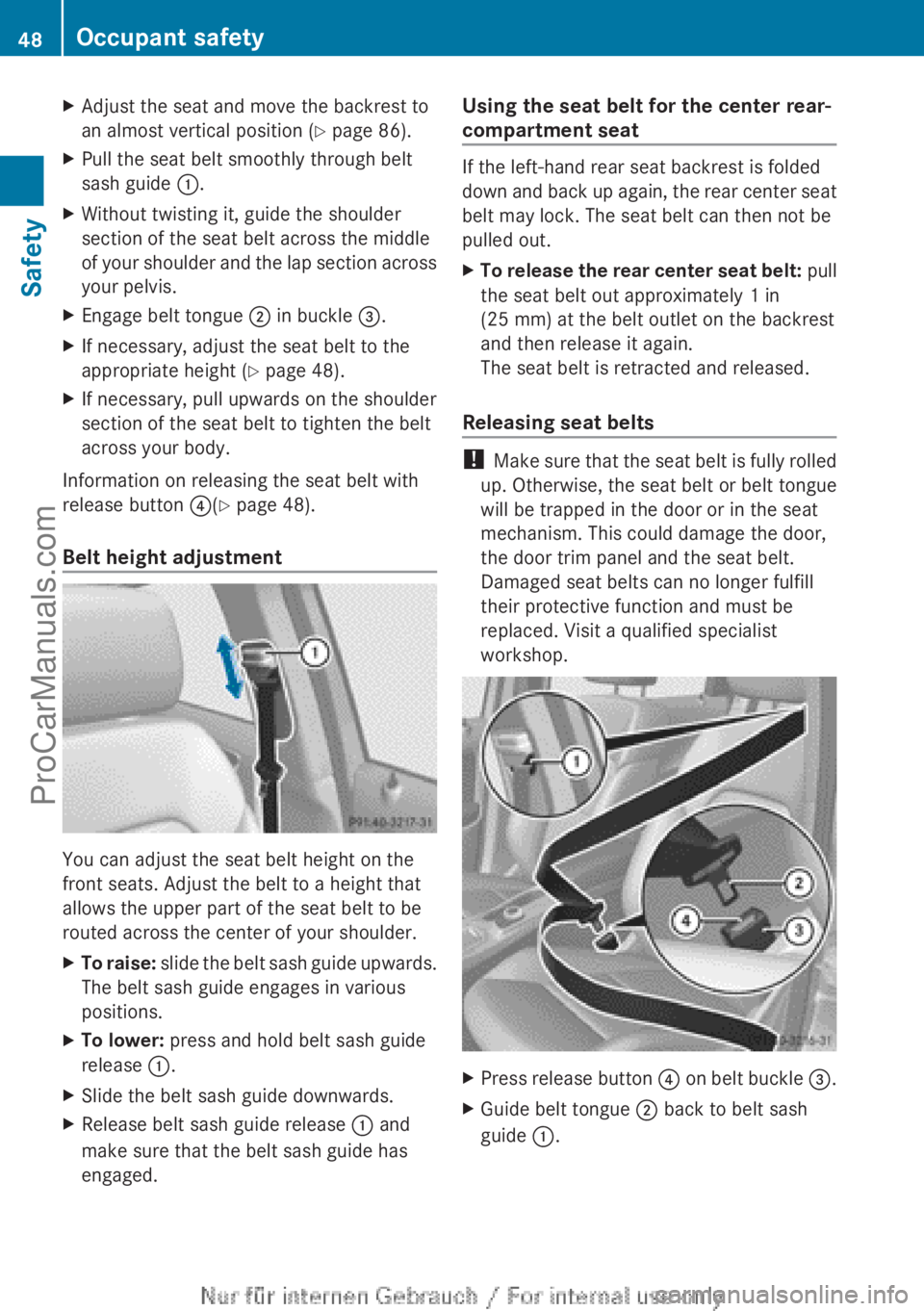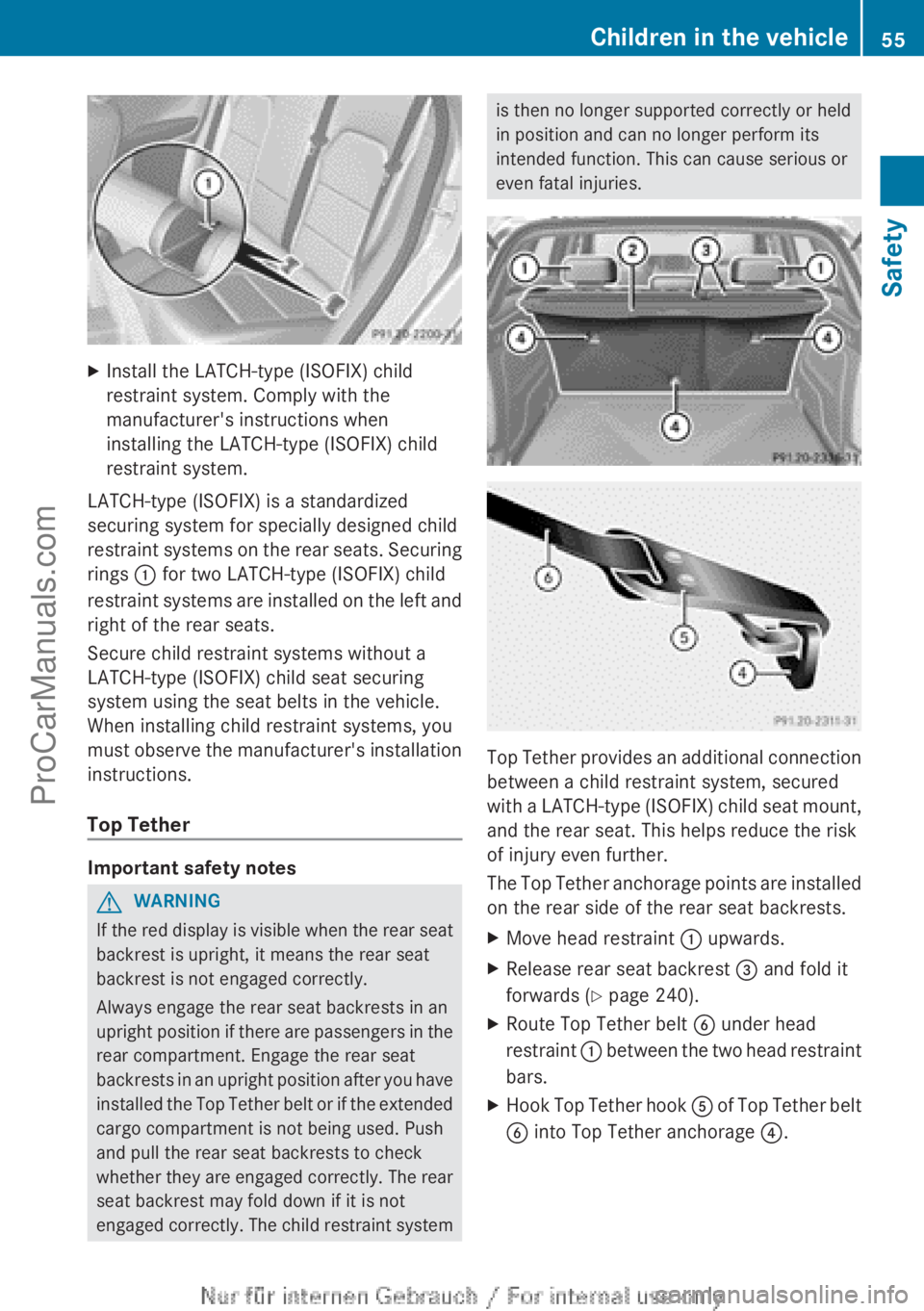2012 MERCEDES-BENZ B-CLASS fold seats
[x] Cancel search: fold seatsPage 17 of 340

(vehicles without the EASY-
VARIO-PLUS system)
.....................240
Folding the backrest (rear
compartment) forwards/back
(vehicles with the EASY-VARIO-
PLUS system) ................................ 241
Seat belts
Adjusting the height ......................... 48
Belt force limiters ............................ 49
center rear-compartment seat
.........48
Cleaning ......................................... 277
Correct usage .................................. 46
Emergency Tensioning Devices ........ 49
Fastening ......................................... 47
Important safety guidelines .............45
Releasing ......................................... 48
Safety guidelines ............................. 40
Warning lamp ................................. 224
Warning lamp (function) ................... 49
Seats
Adjusting (electrically) .....................88
Adjusting (manually) ........................ 88
Adjusting the 4-way lumbar
support ............................................ 90
Adjusting the head restraint ............ 89
Cleaning the cover ......................... 276
Correct driver's seat position ........... 86
Important safety notes .................... 87
Seat heating problem ...................... 91
Storing settings (memory function) .. 95
Switching seat heating on/off ......... 91
Sensors (cleaning instructions) .......275
Service menu (on-board computer) . 196
Service products Brake fluid ..................................... 332
Coolant (engine) ............................ 333
Engine oil ....................................... 332
Fuel ................................................ 330
Important safety notes .................. 329
Refrigerant (air-conditioning
system) .......................................... 334
Washer fluid ................................... 334
Service work
see ASSYST PLUS
Settings
Factory (on-board computer) ......... 199
On-board computer ....................... 196
Setting the air distribution ...............126Setting the airflow
............................ 126
Side impact air bag ............................. 44
Side marker lamp (display
message) ............................................ 211
Side windows Cleaning ......................................... 274
Convenience closing feature ............ 78
Convenience opening feature
..........78
Important safety information ........... 77
Opening/closing .............................. 77
Problem (malfunction) .....................79
Resetting ......................................... 79
Sliding sunroof
see Panorama roof with power
tilt/sliding panel
SmartKey
Changing the battery ....................... 70
Changing the programming ............. 69
Checking the battery ....................... 70
Convenience closing feature ............ 78
Convenience opening feature .......... 78
Display message ............................ 223
Door central locking/unlocking ....... 68
Important safety notes .................... 68
Loss ................................................. 72
Mechanical key ................................ 69
Positions (ignition lock) ................. 135
Problem (malfunction) .....................72
Starting the engine ........................ 135
SmartKey positions (ignition lock) ..135
Snow chains ...................................... 301
Sockets Center console .............................. 251
Luggage compartment ................... 251
Points to observe before use ......... 250
Rear compartment ......................... 251
Specialist workshop ............................ 24
Speed, controlling see Cruise control
Speedometer
Activating/deactivating the
additional speedometer .................196
Digital ............................................ 190
In the Instrument cluster ................. 29
Segments ...................................... 187
Selecting the unit of measurement 196
see Instrument cluster Index
15
ProCarManuals.com
Page 37 of 340

Door control panel
Function Page
:
Opens the door 73
;
%& Unlocks/locks
the vehicle
74
=
r45= Saves
the seat
and exterior mirror
settings 95
?
Adjusts the seats
electrically
88
A
7Zö\
Adjusts and folds the
exterior mirrors in/out
electrically
92 Function Page
B
W Opens/closes the
side windows
77
C
n Activates/
deactivates the override
feature for the side
windows in the rear
compartment
58Door control panel
35
At a glance
ProCarManuals.com
Page 50 of 340

X
Adjust the seat and move the backrest to
an almost vertical position ( Y page 86).
X Pull the seat belt smoothly through belt
sash guide :.
X Without twisting it, guide the shoulder
section of the seat belt across the middle
of your shoulder
and the lap section across
your pelvis.
X Engage belt tongue ; in buckle =.
X If necessary, adjust the seat belt to the
appropriate height ( Y page 48).
X If necessary, pull upwards on the shoulder
section of the seat belt to tighten the belt
across your body.
Information on releasing the seat belt with
release button
?(Y page 48).
Belt height adjustment You can adjust the seat belt height on the
front seats. Adjust the belt to a height that
allows the upper part of the seat belt to be
routed across the center of your shoulder.
X
To raise: slide the belt sash guide upwards.
The belt sash guide engages in various
positions.
X To lower: press and hold belt sash guide
release :
.
X Slide the belt sash guide downwards.
X Release belt sash guide release : and
make sure that the belt sash guide has
engaged. Using the seat belt for the center rear-
compartment seat If the left-hand rear seat backrest is folded
down and
back
up again, the rear center seat
belt may lock. The seat belt can then not be
pulled out.
X To release the rear center seat belt: pull
the seat belt out approximately 1 in
(25 mm) at the belt outlet on the backrest
and then release it again.
The seat belt is retracted and released.
Releasing seat belts !
Make sure
that
the seat belt is fully rolled
up. Otherwise, the seat belt or belt tongue
will be trapped in the door or in the seat
mechanism. This could damage the door,
the door trim panel and the seat belt.
Damaged seat belts can no longer fulfill
their protective function and must be
replaced. Visit a qualified specialist
workshop. X
Press release button ?
on belt
buckle =.
X Guide belt tongue ; back to belt sash
guide :.48
Occupant safety
Safety
ProCarManuals.com
Page 57 of 340

X
Install the LATCH-type (ISOFIX) child
restraint system. Comply with the
manufacturer's instructions when
installing the LATCH-type (ISOFIX) child
restraint system.
LATCH-type (ISOFIX) is a standardized
securing system for specially designed child
restraint systems on
the rear seats. Securing
rings : for two LATCH-type (ISOFIX) child
restraint systems are installed on the left and
right of the rear seats.
Secure child restraint systems without a
LATCH-type (ISOFIX) child seat securing
system using the seat belts in the vehicle.
When installing child restraint systems, you
must observe the manufacturer's installation
instructions.
Top Tether Important safety notes
G
WARNING
If the red display is visible when the rear seat
backrest is upright, it means the rear seat
backrest is not engaged correctly.
Always engage the rear seat backrests in an
upright position if
there are passengers in the
rear compartment. Engage the rear seat
backrests in an upright position after you have
installed the Top Tether belt or if the extended
cargo compartment is not being used. Push
and pull the rear seat backrests to check
whether they are engaged correctly. The rear
seat backrest may fold down if it is not
engaged correctly. The child restraint system is then no longer supported correctly or held
in position and can no longer perform its
intended function. This can cause serious or
even fatal injuries.
Top Tether provides an additional connection
between a child restraint system, secured
with a
LATCH-type
(ISOFIX) child seat mount,
and the rear seat. This helps reduce the risk
of injury even further.
The Top Tether anchorage points are installed
on the rear side of the rear seat backrests.
X Move head restraint : upwards.
X Release rear seat backrest = and fold it
forwards ( Y page 240).
X Route Top Tether belt B under head
restraint : between the
two head restraint
bars.
X Hook Top Tether hook A of
Top
Tether belt
B into Top Tether anchorage ?. Children in the vehicle
55
Safety Z
ProCarManuals.com
Page 90 of 340

heating should also not be used to dry
the seats.
R clean the seat covers as recommended;
see the "Interior care" section.
R do not transport heavy loads on the
seats. Do not
place sharp objects on the
seat cushions, e.g. knives, nails or tools.
The seats should only be occupied by
passengers, if possible.
R when the seat heating is in operation, do
not cover the seats with insulating
materials, e.g. blankets, coats, bags,
seat covers, child seats or booster seats.
! Make sure that there are no objects in the
footwell or behind the seats when resetting
the seats. There is a risk that the seats
and/or the objects could be damaged.
i The head restraints in the front and rear
seats can be removed. 1
For more information, contact a qualified
specialist workshop.
i Further related subjects:
R Luggage compartment enlargement
(folding down the rear seats)
(Y page 240) Adjusting the seats manually Seat fore-and-aft adjustment
X
Lift handle : and slide the seat forwards
or backwards.
X Release lever : again.
Make sure
that
you hear the seat engage in
position.
Backrest angle X
Relieve the pressure on the backrest.
X Turn handwheel ? forwards or
backwards.
Seat height X
Pull handle = upwards or push it down
repeatedly until the seat has reached the
desired height.
Seat cushion angle Adjust the angle so that your thighs are lightly
supported.
X
Turn handwheel ; forwards or
backwards. Adjusting the seats electrically
:
Head restraint height 2
; Seat cushion angle
= Seat height
? Seat fore-and-aft adjustment
A Backrest angle
1 Not on vehicles with sports seats.
2 Not available on vehicles with sports seats.88
Seats
Seats, steering wheel and mirrors
ProCarManuals.com
Page 92 of 340

Rear seat head restraints
Adjusting the rear seat head restraint
height
X
To raise: pull the head restraint up to the
desired position.
X To lower: press release catch : and push
the head restraint down until it is in the
desired position.
Removing and installing the rear seat
head restraints G
WARNING
If head restraints are not installed and
adjusted correctly, they cannot provide
protection as intended.
There is an increased
risk of injury in the head and neck area, e.g.
in the event of an accident or when braking.
Always drive with the head restraints
installed. Before driving off, make sure for
every vehicle occupant that the center of the
head restraint supports the back of the head
at about eye level.
The rear head restraints on the outer seats
can be removed and re-installed. X
Fold the seat backrest slightly forwards in
order to remove the head restraint
(Y page 240).
X To remove: pull the head restraint up to
the stop.
X Press release catch : and pull the head
restraint out of the guides.
X To re-install: insert the head restraint so
that the notches on the bar are on the left
when viewed in the direction of travel.
X Push the head restraint down until you hear
it engage in position. Adjusting the 4-way lumbar support
You can adjust the contour of the front seat
backrests individually to provide optimum
support for your back. :
To raise the backrest contour
; To soften the backrest contour
= To lower the backrest contour
? To harden the backrest contour90
Seats
Seats, steering wheel and mirrors
ProCarManuals.com
Page 95 of 340

defroster is switched on and the outside
temperature is
low.
Mirror heating lasts up to
10 minutes.
i You can also heat up the exterior mirrors
manually by switching on the rear window
defroster.
Folding the exterior mirrors in or out
electrically X
Make sure that the SmartKey is in position
1 or 2 in the ignition lock.
X Briefly press button :.
Both exterior mirrors fold in or out.
i Make sure that the exterior mirrors are
always folded out fully while driving. They
could otherwise vibrate.
i If you are driving faster than
30 mph (47 km/h ), you can no longer fold
in the exterior mirrors.
Setting the exterior mirrors If the battery has been disconnected or
completely discharged, the exterior mirrors
must be reset. The exterior mirrors will
otherwise not fold in when you select the
"Fold in
mirrors
when locking" function in the
on-board computer (Y page 199).
X Make sure that the SmartKey is in
position 1 in the ignition lock.
X Briefly press button :. Folding the exterior mirrors in or out
automatically If the "Fold in mirrors when locking" function
is activated in the on-board computer
(Y page 199):
R
the exterior mirrors
fold in automatically as
soon as you lock the vehicle from the
outside.
R the exterior mirrors fold out again
automatically as soon as you unlock the
vehicle and then open the driver's or front-
passenger door.
i If the exterior mirrors have been folded in
manually, they do not fold out.
Exterior mirror pushed out of position If an exterior mirror has been pushed out of
position, proceed as follows:
X
Vehicles without electrically folding
exterior mirrors:
move
the exterior mirror
into the correct position manually.
X Vehicles with electrically folding
exterior mirrors: press and hold mirror-
folding button ( Y page
93) until you hear a
click and then the mirrors engage in
position.
The mirror housing is engaged again and
you can adjust the exterior mirrors as usual
(Y page 92). Automatic anti-glare mirrors
The "Automatic anti-glare
mirrors" function is
only available if the vehicle is equipped with
the "Mirrors package".
The rear-view mirror and the exterior mirror
on the driver's side automatically go into anti-
glare mode if:
R the ignition is switched on and
R incident light from headlamps strikes the
sensor in the rear-view mirror.
The mirrors do not go into anti-glare mode if
reverse gear is engaged or the interior lighting
is switched on. Mirrors
93
Seats, steering wheel and mirrors Z
ProCarManuals.com
Page 238 of 340

Useful information
i This Operator's Manual describes all
models and all standard and optional
equipment of your vehicle available at the
time of publication of the Operator's
Manual. Country-specific differences are
possible. Please note
that your vehicle may
not be equipped with all features
described. This also applies to safety-
related systems and functions.
i Read the information on qualified
specialist workshops: ( Y page 24).Loading guidelines
G
WARNING
If objects, luggage or loads are not secured or
not secured sufficiently, they could slip, tip
over or be
flung around and thereby hit vehicle
occupants. There is a risk of injury,
particularly in the event of sudden braking or
a sudden change in direction.
Always store objects so that they cannot be
flung around. Secure objects, luggage or
loads against slipping or tipping before the
journey. G
WARNING
Combustion engines emit poisonous exhaust
gases such as
carbon monoxide. If the tailgate
is open when the engine is running,
particularly if the vehicle is moving, exhaust
fumes could enter the passenger
compartment. There is a risk of poisoning.
Turn off the engine before opening the
tailgate. Never drive with the tailgate open.
The handling characteristics of a laden
vehicle are dependent on the distribution of
the load within the vehicle. For this reason,
you should observe the following notes when
transporting a load:
R Never exceed the maximum permissible
gross vehicle weight or the gross axle weight rating of the vehicle (including
occupants). The
values
are specified on the
vehicle identification plate on the B-pillar of
the driver's door.
R The cargo compartment is the preferred
place to carry objects.
R Position heavy loads as far forwards as
possible and as low down in the cargo
compartment as possible.
R The load must not protrude above the
upper edge of the seat backrests.
R Always place the load against the rear or
front seat backrests. Make sure that the
seat backrests are securely locked into
place.
R Always place the load behind unoccupied
seats if possible.
R Use the cargo tie down rings and the parcel
nets to transport loads and luggage.
R Use cargo tie-down rings and fastening
materials appropriate for the weight and
size of the load.
R Hook in the cargo net when loading.
R The maximum load capacity of the stowage
well under the cargo compartment floor is
55 lbs (25 kg).
R Secure the load with sufficiently strong and
wear-resistant tie-downs. pad sharp edges
for protection.
! Do not position the load on one part of the
folding cargo compartment floor only. The
maximum load capacity of the folding cargo
compartment floor is 220 lbs (100 kg).
Distribute the weight evenly to avoid
damaging the cargo compartment floor.
Place a solid board under the load if
necessary. Please note that the load on the
cargo compartment floor will be increased
when the load is lashed down. 236
Loading guidelines
Stowage and features
ProCarManuals.com